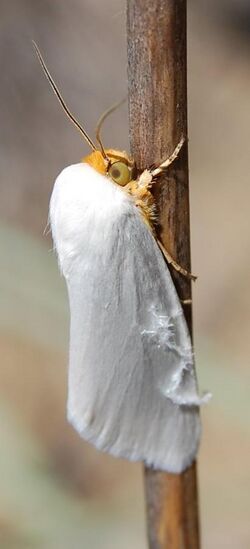Biology:Schinia bimatris
| Schinia bimatris | |
|---|---|

| |
| adult white flower moth | |
| Scientific classification | |
| Domain: | Eukaryota |
| Kingdom: | Animalia |
| Phylum: | Arthropoda |
| Class: | Insecta |
| Order: | Lepidoptera |
| Superfamily: | Noctuoidea |
| Family: | Noctuidae |
| Genus: | Schinia |
| Species: | S. bimatris
|
| Binomial name | |
| Schinia bimatris (Harvey, 1875)
| |
| Synonyms | |
| |
The white flower moth (Schinia bimatris) is a moth of the family Noctuidae found in the United States and Canada .[1][2] It is designated as Endangered under Canada's Species At Risk Act and Manitoba's Endangered Species and Ecosystems Act.[3][4]
Description
The appearance of white flower moth larvae is unknown. The wings, thorax, and abdomen of adult moths are completely white, while the head is orange.[1][5] Adults have a wingspan of about 30 mm (1.2 in).[1][5]
Range
The range of this species includes much of the south-central and south-eastern United States and a disjunct population in the Carberry sandhills in Manitoba, Canada.[1][2][6]
Ecology
In the United States, the white flower moth has been recorded in coastal longleaf pine woodlands, while in Canada it is restricted to open sand dune areas.[1][6] The larval food plant(s) has yet to be determined but it has been suggested that the larvae may feed on Nuttall's Evening-primrose (Oenothera nuttallii).[1] The adults are primarily nocturnal but have been observed flying during the day.[1][6]
Taxonomy
This species was first described by Leon F. Harvey in 1875 as Pippona bimatris from specimens collected in Bosque County, Texas , by Gustav Belfrage, but was later transferred to Schinia.[5][7]
References
- ↑ 1.0 1.1 1.2 1.3 1.4 1.5 1.6 Schinia bimatris Report by the Committee on the Status of Endangered Wildlife in Canada. Retrieved on 2009-10-06.
- ↑ 2.0 2.1 , Wikidata Q97158808
- ↑ "Species at risk registry". https://species-registry.canada.ca/index-en.html#/species/853-585.
- ↑ "Agriculture and Resource Development | Province of Manitoba" (in en). https://www.gov.mb.ca/fish-wildlife/wildlife/ecosystems/index.html.
- ↑ 5.0 5.1 5.2 , Wikidata Q93561883
- ↑ 6.0 6.1 6.2 , Wikidata Q95288853
- ↑ , Wikidata Q94329025
Wikidata ☰ Q7431354 entry
 |

